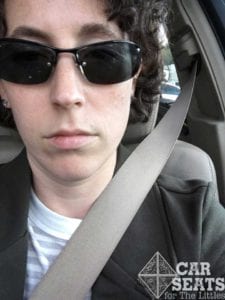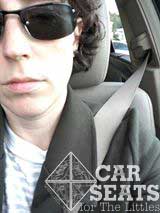Every time we post an article about big kids riding in booster seats on our Facebook page, we also talk about The Five Step Test. This test determines whether or not a child is ready to move from a booster seat to the vehicle seat belt alone.
Developed by Stephanie Tombrello of SafetyBeltSafe, U.S.A., the test offers an understanding of when the vehicle seat belt alone will work for a child and when it won’t. The fit varies by car and by seating position. A child may fit better without a booster seat in the third row of the minivan, but need a booster in the second row of that same van for two additional years. Sometimes kids are well into their tweens or even starting their teen years before they fit better without a booster seat than with one.
The Short Answer
Some young adults fit better in the seat belt than their parents. My teenager is as tall as I am. As a short Child Passenger Safety Technician, I feel the pain of other short parents. We get questions about this often — “I’m an adult, I don’t pass the five step test. Do I need a booster seat?” The short answer is no, you don’t.
The Longer Answer
Adults have a skeleton that is fully formed and full strength. Kids in the 8-10 year old range don’t. Even if children are the same height as their parents, they have immature skeletons that are not completely ossified. That means that their bones are not as strong as our adult skeletons are.
When a child uses a booster until they can consistently pass the Five Step Test, the booster seat helps take some of the direct crash force off of their young skeleton, dispersing those forces to the strongest bones. By the time they’ve grown enough to be out of a booster in nearly every vehicle, they’re getting toward puberty, which brings another spectacular growth spurt for the skeleton.
Ideally, a child meets all of those criteria before they move out of a booster. An adult is well beyond puberty. We’ve got strong bones that can take more of an impact from another object or the airbag better than a child’s skeleton.
The Vehicle Seat Belt on the Neck

Short adult with the vehicle seat belt on the neck
The vehicle seat belt on the neck is annoying. I completely completely understand this. I want everyone reading this to really comprehend that yes, I understand this complaint. Even with my seat belt adjusted as low as it goes in my car, and my vehicle seat is adjusted properly for me to drive, my seat belt rubs on my neck. This is the single largest complaint we hear from short adults (and some tall ones, thanks to wide variations in seat belt geometry).

Short adult and vehicle seat belt
Here’s why this is okay. With your fingers, trace the line of your collarbone. Go all the way out onto the shoulder, and back toward your neck. The bone is a lot longer than most people realize. To have the seat belt centered on that bone means it’s right next to the neck, or occasionally touching the neck. But your body will run out of empty space next to your neck long before it’ll run out of collarbone. So if you’re uncomfortable, it’s a comfort factor, but not a safety one. I tend to put my hood (if I’m wearing one) between my body and the belt, or pull my collar up, or sometimes fold my collar under. And sometimes I readjust the seat or the belt to make myself more comfortable. But I don’t worry a whole lot about it crushing my trachea. Use your fingers to trace your anatomy, the trachea is behind the collarbones. If it’s that bad, I really need to make adjustments. It’s usually just uncomfortable.
The Lap Portion
For the lap portion of the seat belt, getting a proper fit means scooting our bums back and adjusting our vehicle seats. There’s not as much leeway for simply moving a collar and making it fine. If the lap belt is too high, please move your vehicle seat higher if possible, or maybe further forward while keeping a safe distance from the airbag; 10″ as a driver, 20″ as a passenger. Sometimes, though, the belt fit is just not good. As long as the top of your hip bone is coming over the top of the seat belt, you don’t need to worry too much. Adult human hip bones are shaped like a gentle crescent, which will help hold the lap belt down.
Shorter Pregnant Women
Please do keep the lap belt under your belly and on your hips as much as possible while you drive. Adjust the shoulder belt as necessary to fit properly as your body changes. And keep in mind that you should have 10 inches between your body and the steering wheel. The relative measurement for taller people is 10 inches from the steering column to the breastbone. If this cannot happen in a particular car, sit as far back as you can, or see if you can trade cars.
When I was pregnant with my second child, I drove a manual transmission car that required me to be close (too close, in retrospect, I didn’t know of the 10 inches then) to the steering wheel. The plan was to switch to my husband’s automatic transmission for the last month or so if necessary so I could continue to drive. It wouldn’t have required a new car, but just trading briefly. If you don’t have a different vehicle available, and you really just don’t fit well in the vehicle seat belt or behind the wheel, you need to make an educated decision about going for a drive or a ride and seeing if it can be avoided.
In Short
See what I did there?
Adults and their adult bones don’t require car seats or booster seats in order to sit properly. Buckle up, adjust the seat belt so it’s over your hips and the middle of your collarbone and you’re on your way!
